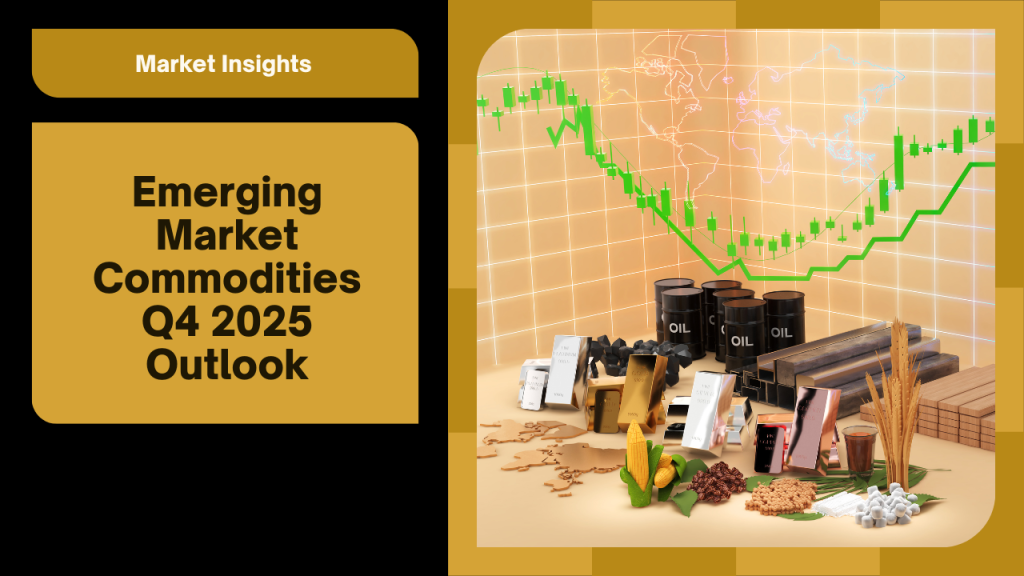
Introduction: Commodities at the Core of EM Investing
Commodities have always been a cornerstone of emerging market (EM) economies. From oil exports in the Middle East to copper in Chile and soybeans in Brazil, resource wealth defines both the opportunities and vulnerabilities of EM. By Q4 2025, commodities once again occupy center stage in the investment debate.
Global investors are asking: will the stabilization of inflation, plateauing of U.S. interest rates, and ongoing energy transition create a new commodities supercycle — or just tactical opportunities?
The Macro Environment for Commodities in Q4 2025
Global Growth and Demand Drivers
- IMF Forecasts: Global GDP ~3.2% in 2025, with EM growth nearly double DM.
- China’s Role: While property struggles persist, infrastructure and green investment stabilize demand for metals.
- India’s Ascent: Infrastructure buildout and energy imports remain central drivers.
Monetary Policy Context
- Fed on hold, easing expected in 2026 → weaker USD trend supports commodities.
- EM central banks ahead in cutting → encourages local demand recovery.
Geopolitical Influences
- OPEC+ policy in focus with oil range-bound.
- Trade realignment (U.S.-China decoupling, EU carbon border taxes) reshaping flows.
- Wars and sanctions (Russia, Middle East) keep energy volatility high.
Energy: Oil & Gas in Q4 2025
Oil Market Outlook
- Brent crude stabilizing at $85–90/bbl.
- Supply discipline by OPEC+ limits downside.
- Demand growth modest but steady, led by Asia.
Winners:
- Saudi Arabia, UAE, Kuwait → fiscal surpluses sustained.
- Nigeria, Angola → production recovery adds to exports.
Risks:
- U.S. shale discipline could break if prices hold high.
- Geopolitical shocks in Middle East remain key wildcard.
Natural Gas
- LNG demand in Asia remains strong, particularly India and Southeast Asia.
- European demand structurally higher post-Ukraine crisis.
- EM producers like Qatar and Mozambique expand capacity.
Metals: The Energy Transition Trade
Copper
- Central to EVs, grids, and renewables.
- Chile and Peru remain dominant, but governance issues impact supply.
- Prices supported >$9,000/ton despite global slowdown.
Lithium & Nickel
- Lithium: Demand surging from EVs, but oversupply risk from new mines in Australia, Argentina.
- Nickel: Indonesia dominates, supplying >40% of global market, increasingly under ESG scrutiny.
Gold
- Stabilized at ~$1,950–2,050/oz.
- Demand driven by central banks (China, India, Turkey) and as hedge vs USD.
- Remains a tactical hedge in EM portfolios.
Agriculture: The Breadbasket of EM
Soybeans & Corn
- Brazil leads global exports, benefiting from Chinese demand.
- Weather risks (El Niño) pose yield uncertainty.
Sugar & Coffee
- Brazil, India dominate sugar; volatility tied to ethanol policy.
- Coffee prices supported by demand recovery and supply constraints in Colombia, Vietnam.
Wheat & Rice
- Ukraine conflict still distorts wheat flows.
- India restricts rice exports to stabilize domestic inflation.
Key Takeaways (Mid-Quarter Insights)
- Commodities in Q4 2025 remain range-bound but supported by EM demand and energy transition.
- Oil stabilizes around $85–90, gold remains a hedge, and copper/nickel underpin green infrastructure.
- Agriculture stays volatile, with Brazil a structural winner.
- For investors, selectivity and diversification remain the golden rules.
Investment Strategies for Commodities in Q4 2025
Direct Commodity Exposure
- Oil Futures & ETFs: Use for tactical plays on OPEC+ supply management.
- Metals ETFs: Copper, lithium, and nickel-focused funds align with energy transition themes.
- Agriculture ETFs: Weather-driven volatility offers trading opportunities.
Equity Proxies
- Energy Majors: EM oil firms (Petrobras, Saudi Aramco) benefit from stable crude.
- Mining Giants: Vale (Brazil), Codelco (Chile), and Indonesian nickel producers central to EV supply chains.
- Agri-Business: ADM, Bunge, and EM agri-exporters benefit from global food demand.
Alternative Vehicles
- REITs & Infrastructure Funds: Linked to logistics, storage, and commodity transport.
- Private Equity: Investments in renewable-linked mining and sustainable agriculture.
Regional Case Studies
Brazil
- Dominates soybeans, sugar, coffee.
- Petrobras plays critical role in oil exports.
- Structural winner in both agriculture and energy.
Indonesia
- Nickel powerhouse, critical for EV supply chains.
- ESG concerns around deforestation and labor rights weigh on sustainability flows.
Chile & Peru
- Copper and lithium dominance continues.
- Governance and social protests create periodic disruptions.
Middle East & Africa
- Gulf oil exporters benefit from fiscal surpluses.
- Nigeria, Angola improving production outlooks.
- South Africa key in platinum group metals (PGMs).
Risk Scenarios
- USD Strength Return
- Would cap upside in commodities broadly.
- China Slowdown
- Hits metals hardest, especially copper.
- Climate Shocks
- El Niño impacts agriculture, extreme weather disrupts supply chains.
- Geopolitical Conflicts
- Escalation in Middle East or Eastern Europe drives oil/gas volatility.
Outlook Beyond Q4 2025
- Energy Transition Supercycle: Demand for copper, nickel, and lithium set to accelerate into 2026.
- Agriculture Volatility: Food security will remain a geopolitical issue.
- Oil Plateau: Stable but unlikely to rally without a major geopolitical shock.
- Investor Angle: Commodities will shift from tactical to structural allocations in diversified EM portfolios.
👉 For a forward-looking perspective, see our Emerging Market Commodities 2026 Outlook.
Leave a Reply